
OIL LEVEL CHECK
See Figure 1
- Park the car on level ground.
- When checking the oil level it is best for the engine to be at operating temperature, although checking the oil immediately after stopping will lead to a false reading. Wait a few minutes after turning off the engine to allow the oil to drain back into the crankcase.
- Open the hood and locate the dipstick. Pull the dipstick from its tube, wipe it clean and reinsert it.

 |  |
Fig. Fig. 1: On some models, the engine oil dipstick is marked
- Pull the dipstick out again and, holding it horizontally, read the oil level. The oil should be between the F and L or high and low marks on the dipstick. If the oil is below the L or low mark, add oil of the proper viscosity through the capped opening on the top of the valve (cylinder head) cover.
- Replace the dipstick and check the oil level again after adding any oil. Be careful not to overfill the crankcase. Approximately 1 quart (0.9L) of oil will raise the level from the L or low mark to the F or high mark. Excess oil will generally be consumed at an accelerated rate.
OIL & FILTER CHANGE
See Figures 2 through 10
The oil and filter should be changed every 7500 miles (12,000 km).
The oil drain plug is located on the bottom, rear of the oil pan (bottom of the engine, underneath the car). The oil filter is located on the side of the engine.
The mileage figures given are the Toyota recommended intervals assuming normal driving and conditions. Normal driving requires that the vehicle be driven far enough to warm up the oil; usually this is about 10 miles (16 km) or so. If your everyday use is shorter than this (one way), your use qualifies as severe duty.
Severe duty includes dusty, polluted or off-road conditions, as well as stop-and-go short haul uses. Regularly towing a trailer also puts the truck in this category, as does constant operation with a near capacity load. Change the oil and filter at 1/2 the normal interval. Half of 7500 equals 3250 miles (5229 km); round it down to the easily remembered 3000 mile (5000 km) interval. For some owners, that may be once a month; for others, it may be six months.
Always drain the oil after the engine has been running long enough to bring it to normal operating temperature. Hot oil will flow easier and more contaminants will be removed along with the oil than if it were drained cold. To change the oil and filter:
- Run the engine until it reaches normal operating temperature.
- Remove the oil filler cap this will allow the oil to drain easier.
- Jack up the front of the car and support it on safety stands.
- Slide a drain pan of at least 6 quarts capacity under the oil pan.

 |  |
Fig. Fig. 2: Loosen the oil drain plug in a counterclockwise direction
- Loosen the drain plug with a wrench. Turn the plug out by hand. By keeping an inward pressure on the plug as you unscrew it, oil won't escape past the threads and you can remove it without being burned by hot oil.

 |  |
Fig. Fig. 3: By keeping an inward pressure on the drain plug as you unscrew it, the oil won't escape past the threads

 |  |
Fig. Fig. 4: Allow the engine oil to drain completely out of the oil pan
- Allow the oil to drain completely and then install the drain plug. Don't overtighten the plug, or you'll be buying a new pan or a replacement plug for stripped threads.
- On some models it will be necessary to remove the engine under cover to access the oil filter.
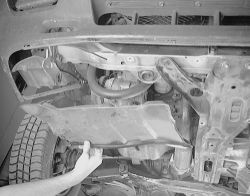
 |  |
Fig. Fig. 5: To access the oil filter on some models, you must remove the engine undercover
- Using a filter wrench, remove the oil filter. Keep in mind that it's holding about one quart of dirty, hot oil. Make certain the old gasket comes off with the filter and is not stuck to the block.
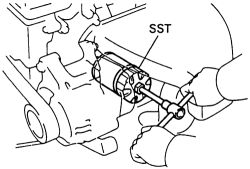
 |  |
Fig. Fig. 6: Special adapters are availble to remove the oil filter
- Empty the old filter into the drain pan and dispose of the filter.
- Using a clean rag, wipe off the filter adapter on the engine block. Be sure that the rag doesn't leave any lint which could clog an oil passage.
- Coat the rubber gasket on the filter with fresh oil. Spin it onto the engine by hand; when the gasket touches the adapter surface give it another 1/2-3/4 turn. No more, or you'll squash the gasket and it will leak.
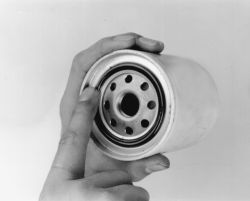
 |  |
Fig. Fig. 7: Before installing a new oil filter, lightly coat the rubber gasket with clean oil
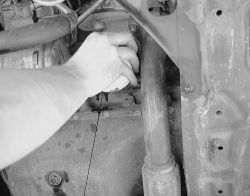
 |  |
Fig. Fig. 8: Fill the filter with oil and install it by hand
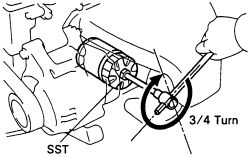
 |  |
Fig. Fig. 9: To seat the filter, use the wrench and tighten the filter an additional 3/4 turn
- Refill the engine with the correct amount of fresh oil through the valve cover. See the "Capacities'' chart.
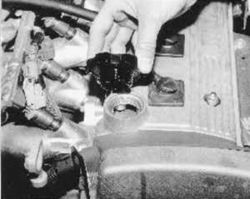
 |  |
Fig. Fig. 10: Add oil through the valve (cylinder head) cover only
- Check the oil level on the dipstick. It is normal for the level to be a bit above the full mark. Start the engine and allow it to idle for a few minutes.
- Shut OFF the engine, allow the oil to drain for a minute, and check the oil level. Check around the filter and drain plug for any leaks, and correct as necessary.